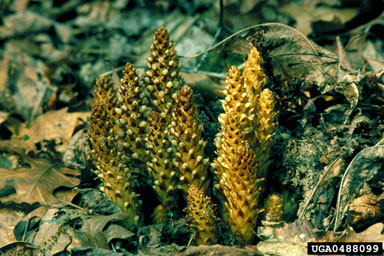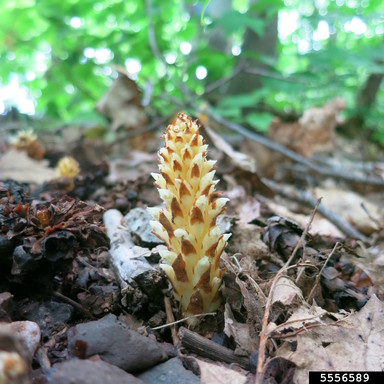Bear Corn, Conopholis americana
By Joyce Tuharsky, WORC Member
In Michigan, if you are hiking through in a deep shady oak or beech forest, you may stumble across a strange growth poking its creepy “fingers” out from around tree roots. Upon closer look, you will find thick fleshy spikes with no leaves, but with brown scales, looking like mini corncobs. These are considered a delicacy by black bears —thus, its common name.

Another common name for this plant is Cancer root, but there is no evidence that this plant has anything to do with cancer. Perhaps it got the name because Native Americans used it for medical purposes. Or perhaps the name reflects the fact that Bear corn is parasitic, deriving all its nourishment from the roots of a host tree. Non-photosynthesizing, it has no green color.
Bear corn lives about 9–10 years. During its first years, an individual plant is mostly hidden underground in the form of a root system that attaches itself to the root of an oak or beech tree, creating a woody gall on the host root. The overall effect of these galls on the health of the tree appears to be minor.

After about 4 years of underground growth, Bear corn starts sending up annual, thick, fleshy, erect stems, 3 to 8 inches in height. These stems can appear as early as April in warm areas or as late as July. Densely packed around each unbranched stem are flowers that are cream to golden-yellow in color, tubular shaped, ½-inch long, 5-parted, and downward facing. The flowers bloom from the bottom to top on the stem. There is no noticeable floral scent. (I could not find information on what type of pollinators pollinate Bear corn.) There are no true leaves on the stems. Instead, brown, 1/2 inch-long, scales appear beneath each flower.
Bear corn flowers bloom for about 3 weeks, then are replaced by capsules containing many small seeds. These seeds have no food reserves, so germination is entirely dependent on proximity to host plant roots. However, where conditions are right, large colonies of Bear corn can flourish. It is possible that bear, deer, and other mammals that eat this plant help disperse its seed to new locations
Although many of us may have never seen Bear corn, it is found in Canada and in every state east of the Mississippi River. While widely distributed, it is not common. It thrives in hardwood forests with rich, well-drained soils, a thick canopy, and where oak or beech trees are present. Bear corn prefers deep shade with less than 2 hours of sunlight, tolerating occasional dry periods.
According to the Michigan Herbarium Flora website, Bear corn has a Coefficient of Conservatism (CC) value of 10 (scale: 1-10). A high CC score means that this species has low tolerance for environmental degradation, such as overgrazing or development. Bear corn needs native habitats with significant ecological integrity, if it is to be conserved within a landscape.
